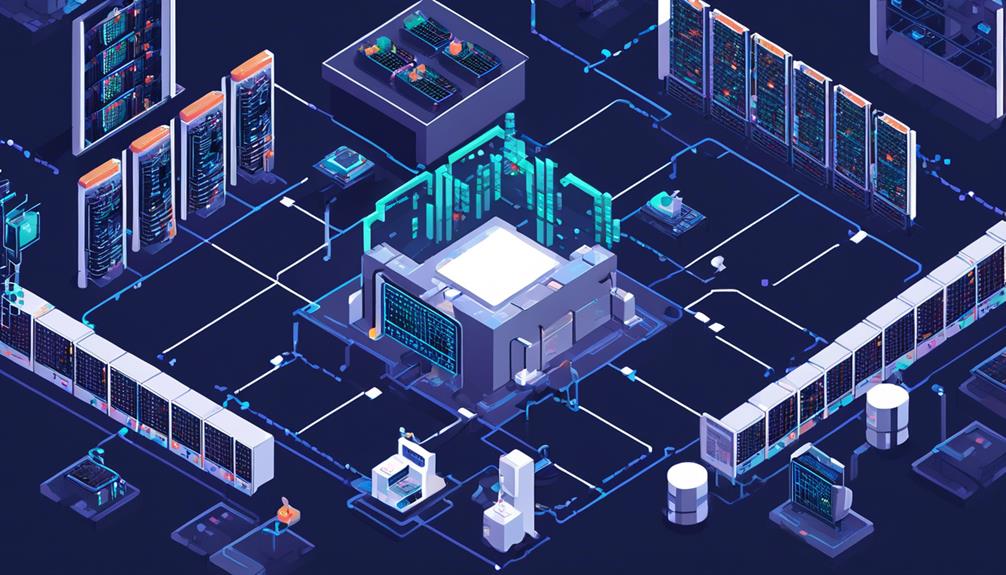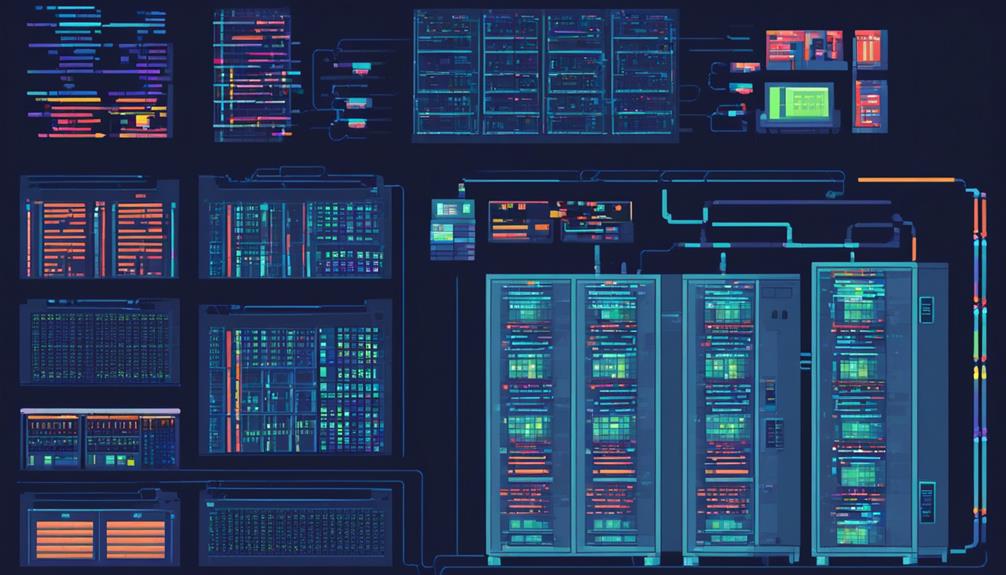As the demand for AI technology continues to rise, cost management in data centers has become a critical factor in maintaining efficiency and profitability. With the increased energy consumption and infrastructure requirements associated with AI tools, organizations are facing mounting expenses.
However, the integration of AI in data center operations presents an opportunity to optimize costs through various strategies, such as AI-driven budget planning, predictive analytics, and intelligent automation. By leveraging AI technologies, organizations can not only reduce costs but also enhance resource allocation, energy efficiency, and security.
In this discussion, we will explore the different ways AI can be utilized to optimize cost management in data centers, providing organizations with valuable insights and solutions to address the challenges they face in this evolving landscape.
Key Takeaways
- AI-driven cost optimization strategies in data centers can minimize equipment failures and downtime through predictive maintenance, optimize energy consumption through resource allocation, streamline processes through intelligent automation, and provide insights into performance and user behavior through data analytics.
- AI-powered budget planning and predictive analytics in data centers enable accurate predictions of future costs and usage trends, optimization of cooling systems, proactive planning for infrastructure requirements, improvement of operational efficiency, and reduction of cooling costs.
- AI-optimized energy efficiency in data centers can minimize downtime and optimize energy usage through predictive maintenance, optimize computing resource allocation based on workload patterns, optimize cooling systems, maximize existing infrastructure utilization, and dynamically adjust cooling settings based on continuous monitoring and analysis.
- The benefits of implementing AI in cost management for data centers include proactive cost management, optimized resource allocation, improved energy efficiency, enhanced operational efficiency, and strengthened data center security. However, integration of AI technologies may require higher costs, skilled personnel, appropriate infrastructure, and real-time monitoring and reporting for effective cost management.
Cost Optimization Strategies

What are the cost optimization strategies that can be implemented in data centers through the utilization of AI-powered technologies?
Data centers are known for their high operational costs, particularly in terms of energy consumption, cooling, and power requirements. However, with the emergence of AI, new opportunities have arisen to reduce these costs and optimize data center operations.
One of the key cost optimization strategies is the implementation of AI-powered predictive maintenance. By utilizing AI algorithms, data centers can minimize equipment failures and downtime, resulting in reduced operational costs. AI can analyze historical data and detect patterns that indicate potential failures, allowing for proactive maintenance to be conducted before any significant issues occur.
Another strategy is the utilization of AI-enabled resource allocation. By leveraging AI algorithms, data centers can optimize energy consumption, leading to reduced energy costs. AI can analyze real-time data on energy usage and dynamically adjust resource allocation to ensure efficient utilization. This not only reduces energy costs but also contributes to environmental sustainability.
Furthermore, AI can be employed for intelligent automation to streamline processes and minimize the need for manual interventions. By automating routine tasks, data centers can reduce operational expenses associated with human labor. AI-powered automation can handle tasks such as monitoring, provisioning, and troubleshooting, allowing data center staff to focus on more critical activities.
Additionally, AI-driven data analytics can play a crucial role in cost optimization. By analyzing large volumes of data, AI algorithms can provide insights into performance and user behavior. This enables data center operators to make informed decisions regarding resource allocation, leading to cost-effective operations.
Lastly, AI can enhance data center security by detecting anomalies and potential breaches. By continuously monitoring data and network traffic, AI algorithms can identify suspicious patterns or activities, reducing the risk of costly cyberattacks and data breaches.
AI-Driven Budget Planning
AI-Driven Budget Planning plays a crucial role in effectively forecasting and managing data center costs through the utilization of AI technology. By analyzing historical data and patterns, AI algorithms can provide accurate predictions of future costs and usage trends. This allows data center operators to make informed decisions regarding resource allocation and budget planning.
One of the key benefits of AI-Driven Budget Planning is its ability to optimize cooling systems in data centers. Cooling is one of the major cost components in data centers, and AI can help optimize energy consumption by analyzing real-time temperature data, airflow patterns, and equipment usage. By identifying inefficiencies and recommending adjustments, AI algorithms can help reduce cooling costs significantly.
Furthermore, AI-Driven Budget Planning enables data center operators to proactively plan for infrastructure requirements. By leveraging machine learning algorithms, AI can forecast future workload demands and identify potential bottlenecks or capacity constraints. This allows operators to allocate budgets and resources more effectively, ensuring that the data center infrastructure is capable of meeting evolving technological demands.
The impact of AI-Driven Budget Planning goes beyond just cost management. It also helps data center operators improve operational efficiency and minimize downtime. By analyzing data from various sources, such as server logs and environmental sensors, AI algorithms can detect anomalies and predict potential failures. This enables operators to take proactive measures to prevent downtime and minimize the associated costs.
Predictive Analytics for Cost Management

Predictive analytics for cost management utilizes AI technology to forecast and optimize expenses in data centers. With the surge in AI and generative AI development, data center operators can now leverage AI algorithms to analyze historical cost data and predict future expenditure patterns. This enables them to identify cost-saving opportunities and optimize resource allocation, leading to improved cost management in AI-enabled data centers.
Here are three key benefits of predictive analytics for cost management in data centers:
- Proactive Cost Management:
By leveraging AI-driven predictive analytics, data center operators can proactively manage costs by identifying potential areas of excessive expenditure. By analyzing historical data and patterns, AI algorithms can predict future expenses and suggest cost-saving measures. This empowers operators to make informed decisions and adapt their cost management strategies accordingly.
- Optimized Resource Allocation:
Predictive analytics for cost management helps data center operators optimize resource allocation. By analyzing past cost data and performance metrics, AI algorithms can determine the most efficient allocation of resources. This ensures that resources are utilized effectively, reducing waste and unnecessary expenses.
- Improved Energy Efficiency:
Energy consumption is a significant cost factor in data centers. Predictive analytics can help optimize energy usage by analyzing historical energy consumption patterns and identifying areas of improvement. By predicting future energy demands, data center operators can implement energy-efficient measures and reduce energy-related costs.
AI-Optimized Energy Efficiency
With the growing demand for efficient cost management in data centers, the focus now shifts to AI-optimized energy efficiency, harnessing the power of machine learning and deep neural networks to conserve energy and reduce operating costs. The data center industry is increasingly relying on AI to analyze data and optimize energy consumption, leading to significant improvements in efficiency.
One of the key areas where AI is making an impact is in predictive maintenance. By analyzing historical data and using machine learning algorithms, AI can identify patterns and predict potential equipment failures before they occur. This allows data center operators to proactively address issues, minimizing downtime and optimizing energy usage.
AI also plays a crucial role in capacity planning and resource utilization. By analyzing data on workload patterns and resource usage, AI algorithms can optimize the allocation of computing resources, ensuring that energy is used efficiently and cost-effectively. This not only reduces energy consumption but also maximizes the utilization of existing infrastructure, leading to significant cost savings.
Furthermore, AI can optimize cooling systems, which are one of the major energy consumers in data centers. By continuously monitoring and analyzing temperature and humidity data, AI algorithms can dynamically adjust cooling settings to maintain optimal conditions while minimizing energy consumption. For example, Google's data centers achieved a 40% reduction in cooling energy through AI-driven energy efficiency measures.
Maximizing Resource Allocation

Efficient resource allocation is a critical component in maximizing the performance and cost-effectiveness of data centers. With the advancement of AI technology, data centers can now leverage AI-driven resource allocation to optimize utilization and enhance efficiency.
Here are three key ways in which AI can maximize resource allocation in data centers:
- Dynamic allocation based on demand: AI can enable data centers to dynamically allocate computing power and storage resources based on the real-time demand. By analyzing patterns and trends in data usage, AI algorithms can intelligently allocate resources where they are needed the most, ensuring that the data center operates at peak efficiency. This not only maximizes resource utilization but also minimizes wastage and reduces costs.
- Server workload management: AI can optimize the distribution of workloads across servers. By continuously monitoring the performance and capacity of servers, AI algorithms can intelligently distribute workloads to ensure balanced resource utilization. This prevents overloading of servers and minimizes the risk of system failures, leading to improved performance and cost-effectiveness.
- Predictive maintenance for energy optimization: AI-enabled predictive maintenance can optimize energy usage and costs in data centers. By analyzing data from sensors and monitoring systems, AI algorithms can predict potential equipment failures and schedule maintenance activities accordingly. This proactive approach helps prevent costly downtime and allows data centers to optimize energy consumption, reducing operational costs and improving overall efficiency.
Intelligent Automation for Cost Reduction
Intelligent automation plays a crucial role in cost reduction within data centers.
By leveraging AI-driven tools, data centers can optimize resource allocation, capacity planning, and maintenance activities.
This automation streamlines processes, minimizes manual interventions, and ultimately leads to more efficient cost management in data centers.
Ai-Driven Cost Optimization
Ai-Driven Cost Optimization employs intelligent automation and predictive analytics to optimize resource allocation and capacity planning, leading to enhanced cost reduction strategies in data centers. By leveraging AI algorithms and predictive analytics, data centers can allocate computing resources more efficiently, reducing operating costs and improving overall efficiency.
Here are three key benefits of Ai-Driven Cost Optimization:
- Automation of maintenance tasks and resource allocation: With AI in data centers, routine maintenance tasks can be automated, reducing the need for manual intervention and minimizing operational costs.
- Improved energy efficiency and security: Ai-Driven Cost Optimization enables proactive maintenance and anomaly detection, enhancing energy efficiency and security in data centers.
- Enhanced operational efficiency and customer satisfaction: By optimizing resource allocation and capacity planning, Ai-Driven Cost Optimization streamlines operations, improves efficiency, and ultimately enhances customer satisfaction.
Implementing AI in data centers allows for better cost management, increased efficiency, and improved overall performance.
Streamlining Data Center Expenses
Implementing artificial intelligence (AI) in data centers revolutionizes cost management through the implementation of intelligent automation, allowing for streamlined expenses and enhanced operational efficiency. AI-driven tools optimize resource allocation, workload management, and capacity planning, leading to cost reduction. By analyzing historical data and utilizing analytics tools, AI technology enables data centers to make data-driven decisions, maximizing efficiency and minimizing costs. Moreover, AI-powered predictive maintenance minimizes equipment failures, reducing operational expenses. AI also enhances data center security by detecting anomalies and potential breaches, mitigating potential costs related to security incidents. Additionally, AI automates tasks such as resource allocation, capacity planning, and maintenance, contributing to reduced operational costs. The use of AI in data centers not only improves cost management but also minimizes the environmental impact and addresses cyber threats effectively.
| AI Technology in Data Centers | Benefits |
|---|---|
| Optimized resource allocation | Cost reduction |
| Enhanced security measures | Minimized potential costs related to security incidents |
| Predictive maintenance | Reduced equipment failure and operational expenses |
| Automated tasks | Streamlined operations and reduced operational costs |
| Data-driven decision-making | Maximized efficiency and minimized costs |
Scalability and Flexibility With AI

Scalability and flexibility in data centers are enhanced with the utilization of AI, allowing for efficient adaptation to dynamic workloads and changing demands. AI can help data centers optimize their operations by using sensors and monitoring systems to analyze data in real-time. This enables data centers to dynamically allocate resources based on the current demand, ensuring that the infrastructure is utilized efficiently.
Here are three ways in which AI enhances scalability and flexibility in data centers:
- Real-time resource allocation: Using AI, data centers can dynamically allocate resources such as computing power, storage, and network bandwidth based on the current workload. By continuously analyzing data from sensors and monitoring systems, AI can identify areas where resources are underutilized and redistribute them to where they are needed the most. This ensures that the data center operates at optimal efficiency and can easily scale up or down as required.
- Quick adjustments to changing demands: The flexibility of AI enables data centers to quickly adjust their infrastructure and resource allocation to meet changing demands. As the demand for data center services fluctuates, AI can analyze data in real-time to identify patterns and trends. This allows data center operators to make informed decisions on how to optimize resource allocation and meet the changing demands of their customers.
- Adapting to the evolving technological landscape: The impact of AI on data centers goes beyond just resource allocation. AI's adaptive capabilities empower data centers to easily accommodate the evolving technological landscape and business needs. By continuously analyzing data and identifying opportunities for improvement, AI can drive innovation and help data centers stay ahead of the curve.
Capacity Planning With AI Technologies
Capacity planning plays a crucial role in meeting the infrastructure demands of AI workloads within data centers, necessitating advanced technological capabilities and the integration of AI technologies. To effectively manage the capacity of data centers, it is essential to have a deep understanding of workload demands and make informed decisions based on them. AI and ML technologies can be leveraged to analyze historical data and predict future workload patterns, enabling data center operators to optimize resource allocation and plan for future growth.
Proactive maintenance is another key aspect of capacity planning with AI technologies. By continuously monitoring the performance of servers, storage systems, and network devices, potential bottlenecks and failures can be identified in advance. This allows for timely interventions, minimizing downtime and ensuring efficient operation of the data center. AI-powered predictive maintenance algorithms can analyze vast amounts of data to identify patterns that indicate potential failures, enabling data center operators to take corrective actions proactively.
Efficient cooling is also a critical consideration in capacity planning. AI workloads generate a significant amount of heat, requiring effective cooling solutions to maintain optimal operating temperatures. AI technologies can analyze real-time temperature and power consumption data to optimize cooling strategies and minimize energy consumption, leading to cost savings and improved performance.
However, integrating AI technologies into capacity planning also comes with higher costs. Advanced chips and expensive components are needed to support AI systems within data centers. Additionally, the implementation of AI technologies requires skilled personnel and appropriate data center technology infrastructure.
Real-Time Cost Monitoring and Reporting

To effectively manage the costs associated with implementing AI technologies in capacity planning, real-time cost monitoring and reporting is crucial in data centers. By continuously monitoring and reporting on costs in real-time, data center operators can gain immediate visibility into their expenditure and make proactive decisions to optimize their cost management strategies.
Here are three key benefits of real-time cost monitoring and reporting in data centers:
- Immediate insights into cost fluctuations: Real-time monitoring and reporting allow data center operators to track expenses as they occur. This provides them with up-to-date information on cost fluctuations, enabling them to identify any unexpected increases or decreases in expenditure. With this knowledge, operators can take timely action to address cost outliers and make informed financial decisions.
- Continuous assessment of cost efficiency: Real-time cost monitoring and reporting enable data center operators to assess the cost efficiency of their operations on an ongoing basis. By analyzing real-time data, operators can identify areas of potential cost savings, such as optimizing energy usage or reallocating resources. This constant assessment allows for proactive maintenance of cost efficiency and the implementation of optimization strategies.
- Quick identification of cost-saving opportunities: Real-time monitoring and reporting also facilitate the quick identification of cost-saving opportunities and potential budget overruns. By having instant access to cost data, operators can identify inefficiencies or areas where costs can be reduced. This enables them to take immediate action and implement cost-saving measures to avoid unnecessary expenses.
Frequently Asked Questions
How Is AI Used in Data Centers?
AI is utilized in data centers for various purposes.
AI-driven predictive maintenance helps in identifying and resolving potential issues before they cause downtime.
AI-powered energy optimization optimizes power consumption by analyzing data center operations.
AI-based workload management ensures efficient allocation of resources.
AI-driven capacity planning assists in predicting future resource requirements.
AI-assisted server provisioning automates the process of deploying and configuring servers.
AI-enabled network optimization optimizes network performance.
AI-guided cooling management helps maintain optimal temperatures.
AI-driven security monitoring detects and mitigates security threats.
How Does AI Reduce Costs?
AI reduces costs in data centers through various mechanisms.
AI-driven predictive analytics enable proactive failure prevention and streamlined maintenance processes, minimizing downtime and associated expenses.
Automated resource optimization and intelligent workload balancing ensure efficient utilization of resources, reducing operational costs.
Enhanced energy efficiency through AI-powered energy optimization techniques leads to significant cost savings and reduced environmental impact.
Smart capacity planning and real-time cost monitoring enable effective cost management.
What Is the Use of AI in Data Management?
AI in data management offers numerous benefits. These include AI-driven analytics, machine learning algorithms, predictive maintenance, real-time resource optimization, automated workload management, intelligent capacity planning, cost-effective energy consumption, enhanced security, and risk management.
These technologies enable data centers to optimize resource allocation, improve efficiency, reduce operational costs, and enhance security measures. With AI, data centers can efficiently process and analyze large volumes of data. This provides valuable insights for performance improvement, user behavior analysis, and trend identification.
How a Virtual Data Center Can Reduce Costs?
A virtual data center can reduce costs through various means.
It can improve energy efficiency, scalability options, and resource optimization, leading to reduced operational expenses.
Automation benefits enable IT staff to focus on more critical tasks, saving time and minimizing expenses.
Hardware consolidation can result in significant savings on maintenance and infrastructure costs.
Enhanced security measures and improved server utilization further contribute to cost reduction.
